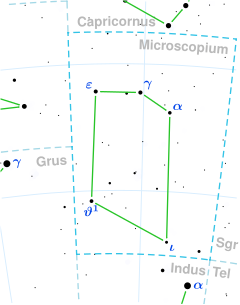| Observation data Epoch J2000 Equinox J2000 | |
|---|---|
| Constellation | Microscopium |
| Right ascension | 21h 20m 45.62633s[1] |
| Declination | −40° 48′ 34.3607″[1] |
| Apparent magnitude (V) | 4.82[2] |
| Characteristics | |
| Spectral type | A7VpSrCrEu[3] |
| U−B color index | -0.07[2] |
| B−V color index | +0.02[2] |
| Variable type | α2 CVn[4] |
| Astrometry | |
| Radial velocity (Rv) | +2.30[5] km/s |
| Proper motion (μ) | RA: +75.480[1] mas/yr Dec.: +8.657[1] mas/yr |
| Parallax (π) | 18.2678 ± 0.5314 mas[1] |
| Distance | 179 ± 5 ly (55 ± 2 pc) |
| Absolute magnitude (MV) | 1.03[6] |
| Details[7] | |
| Mass | 2.32+0.18 −0.26 M☉ |
| Radius | 2.35±0.34 R☉ |
| Luminosity | 36.3+8.4 −6.8 L☉ |
| Surface gravity (log g) | 4.06±0.12 cgs |
| Temperature | 9,240±480 K |
| Metallicity [Fe/H] | 0.00[8] dex |
| Rotational velocity (v sin i) | 43.7±1.7 km/s |
| Age | 437±209 Myr |
| Other designations | |
| Database references | |
| SIMBAD | data |
θ1 Microscopii, Latinized as Theta1 Microscopii, is a suspected binary star[10] system in the southern constellation of Microscopium. It is visible to the naked eye was a faint, white-hued point of light with an apparent visual magnitude of 4.82.[2] The distance to this system is approximately 179 light years based on parallax.[1]

The primary is an α2 CVn variable with a period of 2.125 days and a magnitude ranging from 4.77 to 4.87,[4] as well as an Ap star, a chemically peculiar star with strong metallic lines in its spectrum.[3][6] It is an A-type main-sequence star with a stellar classification of A7VpSrCrEu,[3] where the suffix notation indicates abundance anomalies of strontium, chromium, and europium. The star is 437 million years old with 2.3 times the mass of the Sun and 2.4 times the Sun's radius. It is radiating 36 times the luminosity of the Sun from its photosphere at an effective temperature of 9,240 K.[7]
Its companion is a magnitude 7.42 star at an angular separation of 0.10″ from the primary along a position angle of 46°, as of 2018.[12]
References
- ^ a b c d e f Brown, A. G. A.; et al. (Gaia collaboration) (August 2018). "Gaia Data Release 2: Summary of the contents and survey properties". Astronomy & Astrophysics. 616. A1. arXiv:1804.09365. Bibcode:2018A&A...616A...1G. doi:10.1051/0004-6361/201833051. Gaia DR2 record for this source at VizieR.
- ^ a b c d Ducati, J. R. (2002). "VizieR Online Data Catalog: Catalogue of Stellar Photometry in Johnson's 11-color system". CDS/ADC Collection of Electronic Catalogues. 2237. Bibcode:2002yCat.2237....0D.
- ^ a b c Abt, Helmut A.; Morrell, Nidia I. (1995). "The Relation between Rotational Velocities and Spectral Peculiarities among A-Type Stars". Astrophysical Journal Supplement. 99: 135. Bibcode:1995ApJS...99..135A. doi:10.1086/192182.
- ^ a b Watson, C. L. (2006). The International Variable Star Index (VSX). The Society for Astronomical Sciences 25th Annual Symposium on Telescope Science. Held May 23–25. Vol. 25. p. 47. Bibcode:2006SASS...25...47W.
- ^ Wilson, R. E. (1953). "General Catalogue of Stellar Radial Velocities". Carnegie Institute Washington D.C. Publication. Carnegie Institution of Washington. Bibcode:1953GCRV..C......0W. ISBN 9780598216885. LCCN 54001336.
- ^ a b Anderson, E.; Francis, Ch. (2012). "XHIP: An extended hipparcos compilation". Astronomy Letters. 38 (5): 331. arXiv:1108.4971. Bibcode:2012AstL...38..331A. doi:10.1134/S1063773712050015. S2CID 119257644. Vizier catalog entry
- ^ a b Sikora, J.; et al. (February 2019). "A Volume-Limited Survey of mCP Stars Within 100pc I: Fundamental Parameters and Chemical Abundances". Monthly Notices of the Royal Astronomical Society. 483 (2): 2300–2324. arXiv:1811.05633. Bibcode:2019MNRAS.483.2300S. doi:10.1093/mnras/sty3105. S2CID 119089236.
- ^ Gontcharov, G. A. (2012). "Dependence of kinematics on the age of stars in the solar neighborhood". Astronomy Letters. 38 (12): 771–782. arXiv:1606.08814. Bibcode:2012AstL...38..771G. doi:10.1134/S1063773712120031. S2CID 118345778. Vizier catalog entry
- ^ "tet01 Mic". SIMBAD. Centre de données astronomiques de Strasbourg. Retrieved 2019-09-03.
{{cite web}}: CS1 maint: postscript (link) - ^ Eggleton, P. P.; Tokovinin, A. A. (September 2008). "A catalogue of multiplicity among bright stellar systems". Monthly Notices of the Royal Astronomical Society. 389 (2): 869–879. arXiv:0806.2878. Bibcode:2008MNRAS.389..869E. doi:10.1111/j.1365-2966.2008.13596.x. S2CID 14878976.
- ^ "MAST: Barbara A. Mikulski Archive for Space Telescopes". Space Telescope Science Institute. Retrieved 8 December 2021.
- ^ Mason, B. D.; et al. (2014). "The Washington Visual Double Star Catalog". The Astronomical Journal. 122 (6): 3466. Bibcode:2001AJ....122.3466M. doi:10.1086/323920. S2CID 119533755.

